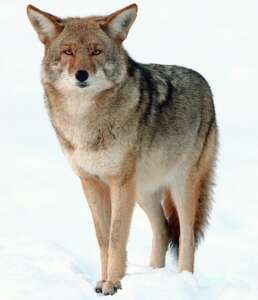
Coyote
Scientific Name: Species: C. latrans
Fun Fact: Coyotes sometimes urinate on their food, possibly to claim ownership over it
Lifespan: The average lifespan of a coyote in the wild is six to eight years, while coyotes in captivity can live twice as long.
Coyote Photo Credit: Yathin S Krishnappa
Description
The coyote is one of the world’s most adaptable animals. It is a native species that has increased its range as a result of human alteration of the landscape and human intolerance of wolves, the coyote’s natural enemy. Once confined to the Great Plains region, it can now be found throughout many parts of North and Central America and is represented by more than a dozen subspecies.
The coyote is a canine native to North America. It is smaller than its close relative, the gray wolf, and slightly smaller than the closely related eastern wolf and red wolf.
The coyote has a wide distribution and abundance throughout North America, southwards through Mexico, and into Central America. The species is versatile, able to adapt to and expand into environments modified by humans. It is enlarging its range, with coyotes moving into urban areas in the Eastern U.S.
The average male weighs 18 to 44 lb and the average female 15 to 40 lb. Their fur color is predominantly light gray and red or fulvous interspersed with black and white, though it varies somewhat with geography. It is highly flexible in social organization, living either in a family unit or in loosely knit packs of unrelated individuals.
Diet
Coyotes have a varied diet consisting primarily of animal meat, including deer, rabbits, hares, rodents, birds, reptiles, amphibians, fish, and invertebrates, though it may also eat fruits and vegetables once in a while. When hunting large prey, the coyote often works in pairs or small groups.
Reproduction
Coyotes are generally monogamous and maintain pair bonds that can last for several years. The breeding season runs from late December through March, and pups are born in the early spring. Litter size depends on a variety of factors but typically ranges from four to seven.
Both parents care for their young, frequently with the help of older offspring. Coyotes make their dens in rocky crevices, dense thickets and sometimes the dens of other animals. The den is abandoned after the pups are weaned but may be used from year to year. Pups are close to adult size at about nine months, when some will begin to leave the pack while others may remain with their parents.
How To Get Rid of Coyotes
Getting rid of coyotes is definitely not for the average homeowner. They have such a superior sense of smell. Any hint of human scent will spook them away and even if caught, most people are not able to dispatch coyotes properly. This is a job for a professional wildlife company. In Georgia and Alabama, call Jarrod’s Pest Control. We have gotten rid of coyotes for 15 years and are the contractor of choice for the City of Columbus, Georgia.
Unfortunately, because coyotes pose a threat to humans and their pets, coyotes must be exterminated upon capture.
(706) 221-8000
Request Free Pest Inspection
EMERGENCY SERVICE AVAIALBLE
Request Free Pest Inspection
EMERGENCY SERVICE AVAIALBLE

